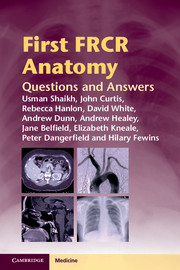Preface
Published online by Cambridge University Press: 05 March 2012
Summary
Preface
The reintroduction of an anatomy section heralded a welcome return to the part 1 FRCR examination. Anatomy is the main cornerstone on which radiology rests and without a good grounding, being an effective radiologist is impossible. Clinicians often call upon radiologists to guide them with anatomy in addition to steering them towards better diagnosis and management of their patients.
Our aim with this book was much more than a simple pre-examination self-assessment text. From its inception, we wanted to write a text that would prove equally as useful after the part 1 FRCR examination and therefore endeavoured to include radiological ‘pearls’ that would serve the radiologist well throughout his or her career. Similarly a non-radiologist reading the text would derive significant benefit in their particular field. The authors have chosen these clinical ‘pearls’, from within their own susbspecialties, rather than purely didactic information that might be obtained in other standard textbooks.
The cases in this book very closely match the standard type of cases likely to be encountered in the actual anatomy section of the examination.
Self-assessment gives immediate feedback to the reader which is often lacking in larger texts. Furthermore it gives a framework for further reading in the various subspecialties. We also believe that this text will be invaluable to medical students, foundation doctors and specialist trainees in surgery and medicine.
- Type
- Chapter
- Information
- First FRCR AnatomyQuestions and Answers, pp. ix - xPublisher: Cambridge University PressPrint publication year: 2012

